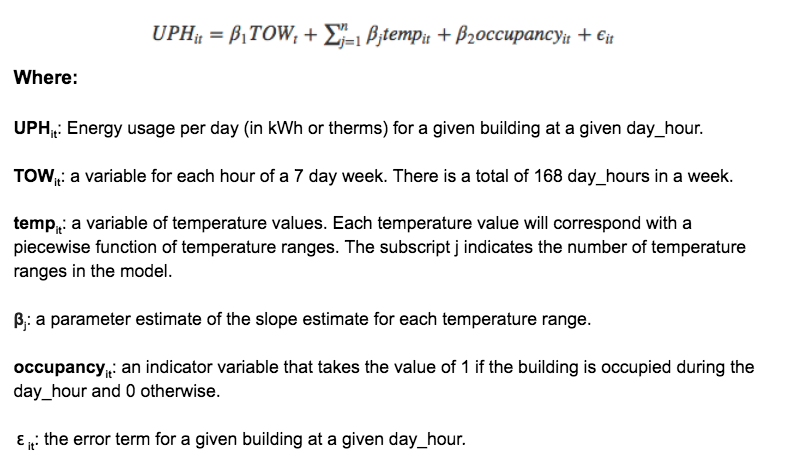|
Week Twelve CalTRACK Update During week twelve, we continued our discussion of hourly methods. In the upcoming week, we will analyze test results for hourly methods on GitHub. We will also be talking about how to log ideas for future improvements. The standing meeting to discuss hourly methods will be on Thursday, May 3rd at 12:00 (PST). Homework:
0 Comments
Week Eleven CalTRACK Update Week eleven was the first week of hourly methods discussion. Developing hourly methods will require discussion and empirical testing of topics unique to hourly methods before we can make final specifications. Topics that must be addressed include:
Time Of Week Temperature Models (TOWT): A proposed model for hourly methods is the TOWT model from Lawrence Berkeley National Labs (LBNL) is shown below. Notes:
Homework:
Week Ten CalTRACK Update The CalTRACK working group finalized discussions on Building Qualifications during the first half of Thursday’s (4/12) meeting and dove into the hourly methods during the second half. Bill Koran from SBW consulting provided a helpful overview of hourly models and the ECAM energy data analysis tool. The major findings of this meeting are summarized below: Building Qualification Observations and Recommendations: Main observations that were driving the recommendations:
 Goals for Hourly Methods: Hourly models are necessary for estimating the load impact of energy efficiency. This makes hourly energy savings important information for aggregators and utilities in an energy efficiency marketplace. Our goal is to establish suitable methods for calculating whole building hourly energy savings for residential and commercial buildings. Additionally, the methods will include guidelines for aggregating site-level savings. Discussion Topics: We have allotted three weeks to test and discuss hourly methods. Below are some important topics that will need to be addressed:
Homework:
Week Nine CalTRACK Update During week nine of CalTRACK, there were continued discussions on building qualification criteria and some introductory comments on hourly methods. The working group meeting will be held on Thursday, April 12th at 12:00 (PST). We will discuss:
Hourly Methods Overview: Hourly methods are a new addition in CalTRACK 2.0 and were not in the first version of CalTRACK. This task involves testing various hourly modeling methods and recommending a standardized approach to hourly modeling, which can reveal the time value of energy efficiency. Importance of Hourly Methods:
Time Of Week and Temperature Models: To start the discussion of hourly methods, it is helpful to consider to existing open source tools. Lawrence Berkeley National Lab has developed an open source time of the week and temperature (TOWT) model to calculate hourly energy savings and is part of the RMV2.0 - LBNL M&V2.0 Tool. A TOWT model predicts hourly energy savings by utilizing hourly temperature data instead of daily or billing period HDD and CDD. Another is ECAM (ENERGY CHARTING & METRICS) developed by Bill Koran at SBW consulting. We look forward to discussion on the working group call about these approaches, and more to frame the approach to empirical tests for the CalTRACK 2.0 hourly methods. Final Note: It is important to remember that CalTRACK methods development is an iterative process. The finalized methods for CalTRACK 2.0, just like v. 1.0, will benefit from field deployment and may need to be revised in future years. We expect this process to result in improved and refined methods with successive iterations. Homework:
|
The purpose of this blog is to provide a high-level overview of CalTrack progress.
For a deeper understanding or to provide input on technical aspects of CalTrack, refer to the GitHub issues page (https://github.com/CalTRACK-2/caltrack/issues). Recordings
2019 CalTRACK Kick Off:
CalTRACK 2.0 July 19, 2018 June 28, 2018 June 7, 2018 May 24, 2018 May 3, 2018 April 12, 2018 March 29, 2018 March 15, 2018 March 1, 2018 February 15, 2018 February 1, 2018 Archives
March 2024
|





 RSS Feed
RSS Feed
